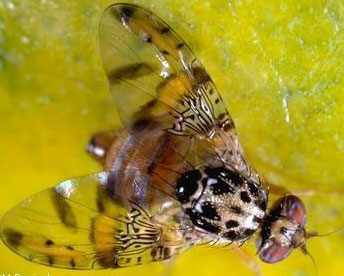Published in the December 6 – 19, 2017 issue of Morgan Hill Life

Mediterranean Fruit Fly
A Mediterranean fruit fly has been spotted in Half Moon Bay. This short, squat fruit fly is known as the World’s Worst Agricultural Pest. The California Dept. of Food & Agriculture estimates that a permanent infestation of the Mediterranean fruit fly, or medfly, would cost California businesses nearly $2 billion a year.
About medflies
Native to sub-Saharan Africa, medflies (Ceratitis capitata) have been making their way around the globe, riding on crops. They are 1/4-inch long, have a black thorax, marked with silver, and a tan abdomen with dark stripes. Wings are clear, with two brown bands, and gray flecks at the base. Eggs are white and oblong. Larvae are white, legless, and carrot shaped. Pupae are encased in a hard, shiny brown puparium.
Damage caused by medflies
Medflies lay their eggs in the skins of more than 250 different fruit, nut, and vegetable crops. Hosts include apples, avocados, citrus, figs, grapes, melons, persimmons, plums, pomegranates, stone fruits, tomatoes, and walnuts. Eggs hatch into maggots that burrow into what we normally eat, making it inedible. Maggots then drop to the ground, or fall with rotting fruit, to pupate in the soil. When an adult emerges, the cycle begins again.
The ripple effect
This problem is not limited to bug-infested foods. Growers will have to use more pesticides, which can lead to ground water contamination and resistant pests. Also, areas with medfly populations are unable to sell their produce, infested or not, to other states and other countries.
Medfly controls
California saw its first medfly in 1975. A state of emergency was declared, and 100 square miles were placed under quarantine. It cost $1 million and took a year, but the medfly was temporarily eradicated. In 1981, Gov. Jerry Brown delayed aerial spraying of Malathion, for the second sighting, claiming environmental concerns. Because of that delay, medflies destroyed millions of dollars of crops, over an area of 530 square miles, including Morgan Hill. Finally, the California National Guard was called upon to create highway checkpoints to confiscate infested produce.
Now, when medflies are spotted, the fight is on: aerial and ground spraying, trapping, irradiation, releasing sterile males, and quarantines. Since 1985, medflies have been found in California in 2007 (Dixon), 2008 (El Cajon), and now, in 2017. Currently, there are two active medfly quarantines in California: Fairfield (Solano Co., just north of Contra Costa) and Sun Valley (Los Angeles Co.). The Half Moon Bay infestation brings that number to three.
What can you do?
Never bring fresh produce, plants, or soil from infested areas into California. Don’t mail fresh produce into uninfested areas either. For more information, contact the California state Dept. of Food and Agriculture at (650) 363-4700. If you think you see even one Medfly, please report it.
You can learn more about garden pests at the South County Teaching and Demo Garden, found at St. Louise Regional Hospital, 9400 No Name Uno. Visit www.mgsantaclara.ucanr.edu/demonstration-gardens/south-county-teaching-and-demonstration-garden. Classes are regularly offered to the public. For class information, check www.mgsantaclara.ucanr.edu/events/ or call (408) 282-3105 between 9:30 a.m. and 12:30 p.m., Monday through Friday.
Kate Russell is a UCCE Master Gardener in Santa Clara County.






